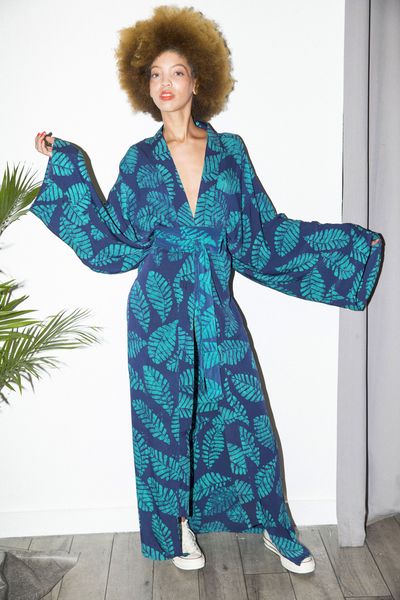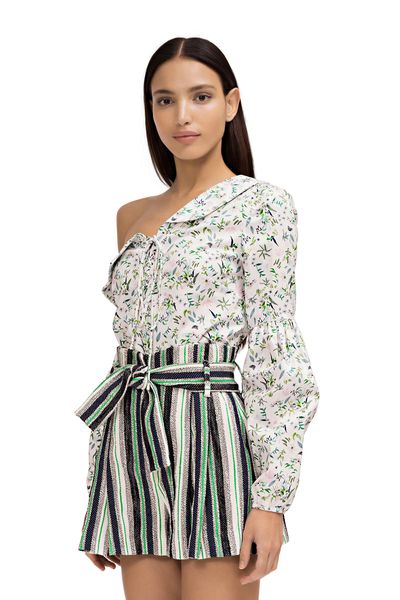Your Everything Guide to a Sustainable Closet
Gone are the days of burlap sacks and tattered hand-me-downs. Dressing green is going chic.
We’ve made strides in applying environmental and ethical practices to food (organic! Non- G.M.O! Locavarism!) and beauty (all-natural! Cruelty-free! Recyclable packaging!), but when it comes to greening our wardrobes, sad hemp hippie-wear still springs to mind. To that, we ask: Who did the Duchess of Sussex turn to for her sexy wedding-reception halter gown? The eco O.G. we all know—Stella McCartney, that’s who. We’ve heard a lot about clothing with a conscience, but we’re going back to basics with a lay of sustainable-fashion land.

Glossary: Alternative Materials
Reebok is developing plant-based sneakers, Osklen has decorated accessories with discarded fish skins—plus eight more innovative fabrics good for the environment.
Eco Drape
What is it? An FSC/Oeko-Tex- Standard-100-certified (see “Seals of Approval,” opposite) viscose that uses less water in its production and is made of wood pulp sourced from trees from renewable forests.
Fan: Zero + Maria Cornejo.
Econyl
What is it? Fabric made from nylon waste (such as old fishing
nets and carpets), developed by Italian company Aquafil.
Fans: Mara Hoffman, H&M, and Speedo.
Get exclusive access to fashion and beauty trends, hot-off-the-press celebrity news, and more.
Nike Flyleather
What is it? Recycled natural leather fiber that uses 90 percent less water and has an 80 percent lower carbon footprint than leather manufactured traditionally.
Word: “Real change happens when we can get our customers to buy a product from the planet’s perspective,” explains Nike chief sustainability officer Hannah Jones. “Seventy-five percent of our apparel now contains recycled materials.”
Orange Fiber
What is it? A silk-like fabric made from Sicily’s citrus-juice by-products, repurposing orange peels and seeds that had amounted to 700,000 tons of waste each year in Italy alone.
Fan: For spring 2017, Ferragamo debuted its first capsule collection of scarves and accessories made from the material.

Microsilk
What is it? A lab-grown silk from Bolt Threads made from proteins brewed with genetically engineered yeast.
Word: “We’re essentially making spider silk, but without the spiders,” says CEO Dan Widmaier.
Next up: Bolt’s latest innovation is Mylo, a vegan leather made from mushrooms.
Recycled Plastic
What is it? Just what it sounds like. Nonprofit group Parley for the Oceans has teamed up with labels like G-Star Raw to combat marine pollution by transforming plastics found in our waterways into high- performance sportswear.
Word: “An estimated 8 million metric tons of plastic enters the oceans from the coasts annually, or somewhere between 4 and 12 million metric tons,” says Parley for the Oceans founder Cyrill Gutsch. “We need to take action in order to avoid destroying our environment.”
Fan: Vionnet just launched a 340-piece Sustainable Surf collection, which uses materials like recycled plastic and eco- leather. Fifty percent of profits will go to Parley for the Oceans.
Tencel
What is it? A cottonlike semisynthetic fiber from Austrian company Lenzing made from the pulp of eucalyptus trees grown on certified sustainable farms. It uses 80 percent less water than cotton and is grown without pesticides.
Fans: Zara, DSTLD (a denim favorite of Kendall Jenner and Gigi Hadid), and Amour Vert (which plants a tree for every tee sold).
What is it? Faux leather that doesn’t harm animals.
Examples: Piñatex, developed by London-based company Ananas Anam, is made from the fibers of pineapple leaves harvested in the Philippines. Meanwhile, Modern Meadow, Vegea, and MycoWorks are creating leatherlike materials out of yeast, grape extracts, and mushroom mycelium.

Seals of Approval
Look for these textile certifications on hangtags and labels the next time you go shopping
Bluesign-certified dyeing facilities use only nontoxic chemicals, monitor their air and water emissions, and ensure that every piece of dyed fabric is safe for consumers, workers, and the environment.
Every year, 150 million trees are cut down to make fabric like viscose, a.k.a. rayon. Certification signifies that products come from responsibly managed forests that maintain their biodiversity and regeneration capacity. 3.1 Phillip Lim has used FSC-certified viscose and Oeko-Tex-certified biodegradable yarn in its collections.
Global Organic Textile Standard (GOTS)
Items carrying the GOTS label grade “organic” must contain at least 95 percent certified organic fibers. The following textile ingredients are also prohibited: toxic heavy metals, formaldehyde, aromatic solvents, GMOs and their enzymes, and azo dyes that release carcinogenic compounds. Gisele Bündchen recently wore a GOTS-certified organic silk-and-cotton Versace custom dress on the red carpet. You can look up products at global-standard.org.
Nest
This nonprofit’s Standards Program for Homes and Small Workshops seal indicates that products have been made ethically by artisans. It was launched with brands like Maiyet and Target.
When a textile meets the criteria of the independent certification system Oeko-Tex, that means it has been tested for harmful substances and is free of carcinogens, azo dyes, and other chemicals, in accordance with the European REACH (Registration, Evaluation, Authorization, and Restriction of Chemicals) standards. Burberry and Christopher Kane have used OekoTex-certified fabrics.

The GuppyFriend Washing Bag helps protect synthetic clothes in the washing machine while trapping microfibers that might end up in our waterways. ($29.75; patagonia.com.)
Chill Out
Setting your washing machine to “cold” (30 degrees Fahrenheit) saves energy and helps your clothes live a little longer. (Heat can break down fibers.)

'Amur’s blouse is made of 97 percent organic material '
Spot-clean as much as possible, and wash your clothes only when necessary. (Try airing out or steaming them instead.) Apart from underwear and workout gear, most items rarely need constant washing
Let's Hang
.
Air- or line-drying clothes can eliminate up to 700 pounds of greenhouse gases annually—the energy equivalent of driving a Prius 2,500 miles.
About 85 percent of dry cleaners use a chemical called perchloroethylene (perc for short) that’s linked to respiratory issues, birth defects, and air pollution. Even if your cleaner advertises that it’s “green” or “organic,” ask if it uses perc, hydrocarbons, or D-5 cleaners—in order to avoid the toxic stuff—and biodegradable bags. When you do dry-clean, remove the cover from clothes as soon as they come back. Keeping them encased traps in chemicals, which can cause condensation and mildew.

So you’re trading car keys for a bike helmet, using a water bottle, and sorting paper from plastics. Good job. Now consider approaching your wardrobe in the same earth-friendly ways.
• Invest in high-quality clothes that you can keep for a long time, and repair garments whenever possible, so you buy fewer pieces over your lifetime.
• Shop your closet and wear things time and again.
• Keep your closet in the cloud, as Rent the Runway CEO and cofounder Jennifer Hyman says, and rent pieces to change up your wardrobe constantly at renttherunway.com, armarium.com (ready-to-wear and couture), letote.com, and closet.gwynniebee.com.
• Most retail receipts are made of thermal paper coated in BPA, which makes them unrecyclable, so opt for an e-mailed version if you need one.
Reuse
• Buy or sell clothing and accessories through consignment sites and apps like the Real Real, Poshmark, and ThredUp.
• GFX (globalfashionxchange.org), which has diverted 23 tons of clothing from landfills since 2013, hosts clothing swaps worldwide.
• Patagonia’s Worn Wear program allows you to shop secondhand for its products online. You’ll also get store credit for trading in your used Patagonia pieces.
• Blue Jeans Go Green partners with retailers from Madewell to Rag & Bone to Wrangler to collect old denim from any brand. Consult the calendar for where it heads next at bluejeansgogreen.org.
• H&M and Levi’s accept clothing and shoes from any brand, and their partner, I:Collect, will ensure that your unwanted garments and footwear are reworn, repurposed, or recycled.
• The North Face’s Clothes the Loop program partners with Soles4Souls to distribute any brand of clothing and shoes dropped off at its stores to help with disaster relief efforts.
• Nike’s Reuse-a-Shoe program transforms worn-out shoes into athletic and playground surfaces. Drop off your old kicks at any of the athletic brand’s stores.
• Check out recycling programs like American Textile Recycling Service, Fabscrap, GrowNYC, Planet Aid, USAgain, and Wearable Collections to find garment-collection services in your city.
Women artisans hand-beaded this Unleashed by Kara Ross organic cotton tee. All clothing or similar styles available at maison-demode.com.
[image id='1f74d40a-48d5-4e18-815b-336cd79154ec' mediaId='fada4649-6f53-4e92-9f3a-b57a32d5d2a8' align='center' size='medium' share='true' caption='' expand='' crop='original'][/image]

Glossary: Lingo Lowdown
A few of the most commonly used sustainable fashion terms and what they mean
Leftover fabric from designers and garment factories that companies repurpose into new pieces and products. Brands known for this practice include Reformation, Viktor & Rolf, and Alexander McQueen.
A socially and environmentally conscious approach to the design, sourcing, and manufacturing of clothing. That means employing artisans with traditional skill sets, making animal-cruelty-free products, providing safe working conditions (e.g., buildings that are up to code), and avoiding sweatshop labor. Brands known for this practice include Brother Vellies, Loomstate, and Lemlem.
Emphasizes sustainable farming methods, support for local communities’ economic development, and safe and equitable conditions—including fair wages—to ensure that workers and local producers in the developing world are not exploited. Check products for certification from a nonprofit like Fairtrade International (fairtradeamerica.org) or Fair Trade USA (fairtradecertified.org).
Falsely leading consumers to believe that a company’s products, actions, or policies are environmentally friendly.
The philosophy that companies and individuals should act in a way that advances the well-being of society and the planet. This includes philanthropic donations made to environmental organizations.
Upcycling
Converting old or discarded materials into another product (e.g., turning fabric scraps, or deadstock, into clothing or recycled plastic bottles into sneakers). Brands known for this practice include Gabriela Hearst, Eileen Fisher (its Resewn line), Timberland, Missoni, Vetements, and Rothy’s.